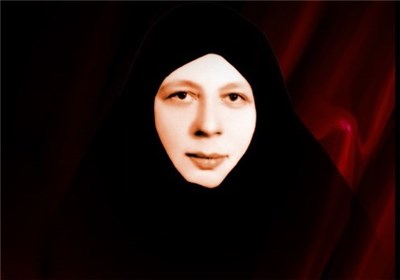Alwaght- On June 12, 1979 a cloak-clad woman carried herself to the holy shrine of Imam Ali in Najaf. Impassioned yet composed she delivered words that would later resonate in the form of mass demonstrations. “Oh people! Why are you silent while your leader has been arrested? Why are you silent while your leader is in prison being tortured? Come out and demonstrate…”
The weight of this speech was felt heavily by the Saddam regime as calls to release Ayatollah Sayyed Mohammad Baqer al-Sadr were made loud and clear. Protests spread from Iraq to Lebanon, Bahrain, and Iran in a show of support for Sadr and against the tyranny of former dictator Saddam Hussein. The woman who gave a voice to this uprising was Amina al-Sadr otherwise known as Bint al-Huda.
Real-life Education
Amina Haidar al-Sadr was born in Kadhimiyah, Baghdad in 1937. She grew up with her mother and two brothers after her father passed away when she was just two years old. Her brothers, especially Sayyed Mohammad Baqer, undertook the task of arming her with an education.
Bint al-Huda grew up with a love of knowledge. She spent her pocket money on books and indulged herself in them. From a young age, she exhibited signs of remarkable brightness.
When she was 20 years old, Amina began writing articles in al-Adhwa magazine, a religious Najafi publication. Her writings grasped the interest of intellectuals in the capital of Islamic religious scholarship.
A reputation for a devotion to education emerged from her role in establishing several schools for girls in Baghdad and Najaf in the 1960’s. She was even headmaster of these religious schools.
But Amina al-Sadr did not leave this world without tangible proof of her extensive knowledge and socio-literary talent. Many books bear her name, or rather her pseudonym of Bint al-Huda, which she adopted to keep a modest profile. Many of the books she authored were compilations of fictional short stories that tackled socio-religious issues.
Yet most notably is her dedication to shed light on the struggles of Muslim women in Iraq.
“To embody the general concepts of the Islamic viewpoint concerning life is the aim behind these stories. I believe concepts at the theoretical level cannot produce a change or an effect as they can when presented in the form of events or incidents from real life,” writes Bint al-Huda in her introduction to a book of short stories.
Bint al-Huda goes on to say that her fiction is inspired by reality.
“If these short stories are knitted of imagination, they are certainly taken from the depth of present-day Muslim girls' lives. Hence, any girl may read in these stories, incidents she has experienced in some way or directly.”
Islamic Feminism
In an essay entitled "Bint al-Huda": A Biographical Study, Bayān Ubayd al-Urayyid, holder of a PhD in international relations and contemporary Islamic media, draws attention to the trend Bint al-Huda set in feminist Islamic media.
“In the tumult of those years, which were rife with ideas and counter ideas, the pioneer of the feminist Islamic media in Iraq was born in the most fragrant and deeply rooted house, and I do not think that she knew that she would one day become a media pioneer. Actually, most references, books and researches which wrote about her sailed with her in fields of Islamic pioneering, in jihad and in martyrdom, in pioneering the Islamic, social, intellectual and educational feminist endeavor, but they did not do justice to her distinctive leadership of the feminist Islamic media. This woman is the martyred Āmina al-Sadr, Bint al-Huda.”
The works of Bint al-Huda were never without a cause, never empty of a message, but rather always diligently aimed to plant the seeds of knowledge and resilience among Muslim women.
“The pen of Bint al-Huda never stopped addressing the Muslim girl, sharpening her mind through all means of addressing the challenges and resisting the temptations of the time,” al-Urayyid conveys.
Perhaps one of the most ardently defended causes by Bint al-Huda is the hijab. She maintained that the headdress was not an obstacle. She persisted in her conviction and attempted to pass it on to others at that time.
In these verses, Bint al-Huda addresses this topic:
“My shyness from the most High is not bent,
Nor has it shackles to my hand sent.
No, nor has this veil blocked me
From my goal, from what I want to be.”
Martyrdom
Almost one year after Bint al-Huda’s speech, Saddam ordered for her arrest as well as that of Ayatollah Mohammad Baqer al-Sadr. In a bid to bury the revolutionary school of thought that the Sadrs’ had established in Iraq, Saddam had the two influential figures tortured for three days. In April 1980, both were reportedly killed at the hands of Saddam himself.
While there is no definite report of where Amina al-Sadr is buried, some say that her body has never been found and that is backed by stories of Saddam dissolving her corpse in acid. Others say she is buried in Wadi al-Salam.
Amina al-Sadr was martyred alongside her brother for a set of principles they believed in. Amina was not merely a political activist and a religious thinker. She was a student and an educator. She was a defender of women’s rights through Islamic theology. She campaigned for women who were too oppressed to speak for themselves and broke the chains that the ruling Baath Party had clasped around people’s lives.
What the Sadrs’ did was nothing short of a reply to the calls of Imam Hussein when he stood before the army of then-caliph and oppressor Yazid Ibn Mu’awiya. The Battle of Karbala had been their inspiration and so when they raised their voices against injustice, they were killed in cold blood.
Some say that when Saddam was asked to show mercy to Bint al-Huda’s on the premise that she was a woman, he was quick to respond, “Kill the brother and spare the sister? You want me to make the same mistake as Yazid?”
Saddam has made the same mistake as many tyrants who think that by killing those who speak against injustice, the revolutionary thoughts would die with them. Instead, the martyrdom of Amina and Ayatollah Mohammad Baqer al-Sadr inspired other revolutionary paths. Today, they are regarded as icons of modern revolutionary Islamic philosophy.
As for Bint al-Huda, both her life and death ascertain that even on frontiers dominated by men, there is a place for women.



























